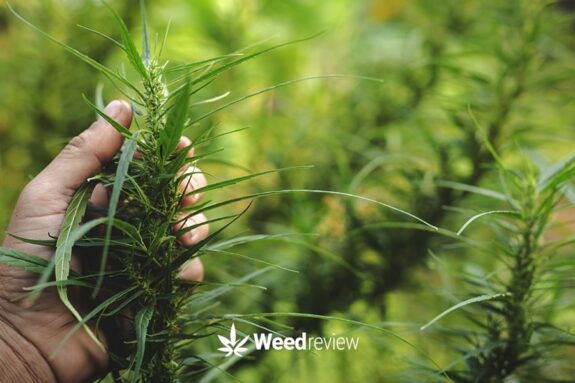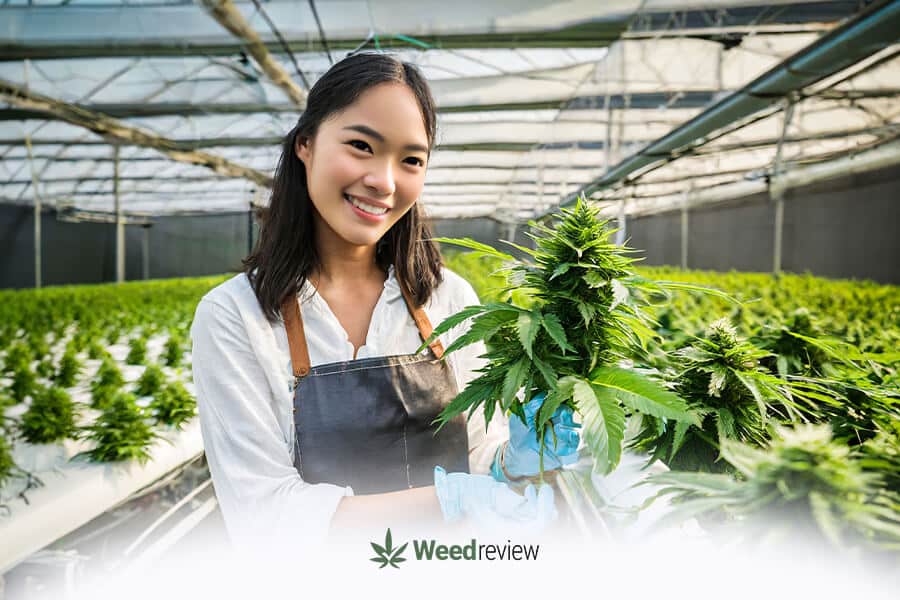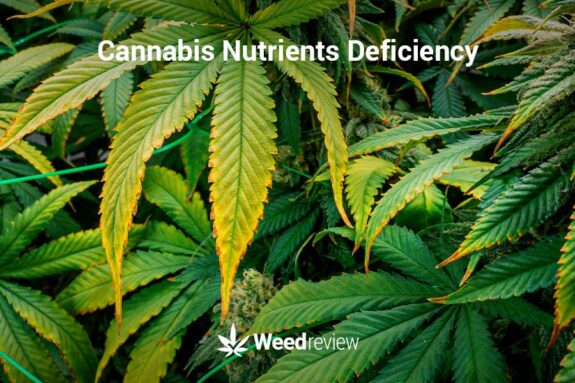
Growing Hydroponic Cannabis: A Starting Guide to Hydroponic Systems, Nutrients, Growing Mediums, Set-ups

Table of Contents
Humans have been growing cannabis for ages, trying various methods over time. Among these, hydroponics is a newer technique quickly becoming a favourite for many.
Hydroponic cannabis cultivation promises strong growth, high yields, and complete control over your plants’ journey from seed to harvest. A hydro setup can be better suited for professional marijuana growers, as it removes soil-related issues while growing bountiful plants.
That said, hydroponics requires extensive knowledge and understanding. It also needs frequent maintenance and a more hands-on approach.
This article will give you a thorough understanding of growing hydroponic cannabis. We will look at the basics of hydro, different types of hydroponic systems, growing mediums, nutrients, and a short starting guide.
What is hydroponics?
Hydroponics is a method of growing plants without soil. Instead of getting food from the soil, the plants feed from a nutrient-rich water solution.
In hydroponics, the plant roots don’t need soil because they’re directly in contact with oxygenated water enriched with the essential nutrients plants need to grow.
The roots are practically in endless contact with water solution, which allows them to absorb far more efficiently than from soil. It is like giving plants a ‘direct feed’ of nutrients.
What are the parts of a marijuana hydroponic system?
You have a container filled with a nutrient solution which feeds the plants. The plants are placed in a tray with the bottom part exposed to the solution mix and, in some cases, air.
Above the water, the plant grows freely. An inert medium is often used in hydroponics, providing a neutral home for the plant’s roots. This is a support structure for the plants, like a sponge holding the water and nutrients but not adding or removing anything.

Key components include:
- Reservoir: Holds the nutrient solution.
- Grow tray: Where plants are placed, allowing roots to access the solution.
- Substrate: Supports plant roots; examples include rockwool, clay pellets, or perlite.
- Water pump: Circulates the nutrient solution from the reservoir to the grow tray.
- Air pump and Air stones: Supply oxygen to the nutrient solution, vital for root health.
- Lighting: Provides essential light with LED or HID options.
- Timer: Automates lighting and water cycles, ensuring consistent conditions.
To grow hydroponic marijuana successfully, you should also familiarise yourself with the basics of growing cannabis indoors.
Advantages of hydroponics
Many indoor cannabis growers favour hydroponic systems thanks to their benefits in terms of plant health and overall yields. Here are some key benefits:
- Increased growth rate: Cannabis grows about 30-50% faster in hydroponic systems than in soil.
- Greater, high-quality yield: The accelerated growth rate and controlled environment often produce a significantly higher yield of much superior quality.
- Water-efficiency: Hydroponic systems use less water than soil-based cultivation because the system recirculates the nutrient-rich water.
- Space-efficiency: You can grow more plants in a smaller space than traditional soil methods.
- Eliminates soil-borne diseases: By removing soil from the garden, you can avoid several soil-related issues, such as insects, moulds, and diseases.
- Better nutrient control: Hydroponics allows for precise control over the nutrients your cannabis plants receive.
- Year-round growth: Hydro set-ups do not depend on climate; you can grow cannabis all year round.
These advantages can help beginners avoid costly mistakes. However, these systems require careful monitoring, leading us to their disadvantages.
Disadvantages of hydroponics
The most significant factor for new growers is that a hydroponic system is less forgiving than soil, meaning a mistake can have quick and lasting effects on your plants. Here are the main disadvantages of growing weed with hydroponics:
- Consistent monitoring: In hydroponics, the cannabis depends on you to provide precisely the right amount of nutrients and water. You’ll need to fix any problems quickly.
- Technical knowledge: Running a successful hydroponic system requires a good understanding of plant nutrition and pH levels.
- Potential for system failures: Hydroponic systems are more prone to mechanical failures, like pump breakdowns or electricity problems. Such issues need quick fixing.
- Can be expensive: Setting up a hydroponic system can require a lot of money, particularly for larger gardens.
- High electricity use: Hydroponic systems rely a lot on electricity. Any power outage, including the lighting, water pumps, and timers, could severely impact the system. It is best to have a backup system, such as a portable generator.
Types of hydroponic growing systems
In the world of hydroponic cannabis cultivation, you’ll encounter two main system types: active and passive.
Each of these marijuana hydroponic systems uses a unique approach to nourishing the plants, offering different advantages that can optimise your cannabis yield.
Active hydroponic systems
Active hydroponic systems work by actively pumping a nutrient-rich water solution directly to the cannabis plant roots, ensuring optimal nourishment and promoting robust growth.
Active hydroponics requires equipment like airstones for aeration, water pumps, reservoir tanks, tubes and pipes, and growing trays.
Such systems offer the following benefits:
- Easy to automate
- Water-efficient
- Rich in oxygen
A drawback here is the potentially higher electricity costs and the need for regular system monitoring.
Deep water culture (DWC)
Deep water culture (DWC) is a simple yet efficient hydroponics system where plants’ roots are suspended in nutrient-rich, oxygenated water. It’s an easy starting point for beginners, as you can make one with something as simple as a bucket.

With this method, the air is supplied through the water via an aquarium air stone or diffuser. The marijuana plants sit in net mesh pots with an inert growing medium to keep them secure.
Nutrient film technique (NFT)
The nutrient film technique (NFT) is a hydroponic method where a thin film of nutrient-rich solution constantly flows over the roots of cannabis plants.

A growing tray houses the plants. A steady stream of nutrient-water solution is constantly fed through this tray for the roots to eat. The solution then drips into the main tank, where an air stone aerates the mix while a water pump feeds the mixture into the tray.
This method can be challenging for beginners because it requires you to control the nutrient and pH levels due to constant recycling. It is necessary to regularly check the run-off solution’s pH and nutrient concentration, as they can change over time.
This system is suitable if you are a commercial grower or are growing multiple plants at scale.
Ebb and flow (flood and drain)
The ebb and flow system, or flood and drain, involves flooding the growing medium with a nutrient solution and then letting it drain back into the reservoir.

The roots are not submerged in the solution continuously. Instead, the growing tray is filled with oxygen and nutrient-rich water for some time and drained back into the main tank. The process then repeats.
This method can be complex for beginners because it requires precise timing. You also need to ensure your plant roots don’t stay soaked with water to prevent roots from rotting.
Drip system
The drip system delivers nutrients directly to plant roots via a network of tubes – much like traditional drip irrigation.
The food solution is fed directly to the base of the plants via tubes – instead of ‘sharing’ it. These tubes can also have control measures to adjust the flow rate individually for each plant in the tray. The excess solution drips in a common reservoir – from where it can reused or discarded.

If you have space, you may place the plants in individual buckets instead of putting them in a common tray (known as the Dutch bucket system).
These systems are different from other methods where all plants soak in the nutrients from a shared pool.
It requires careful monitoring of nutrient delivery rates to avoid over-saturation. If you use this method, you will have always to fine-tune the drip rate to match your individual plant’s growth stage. For example, a vegetative plant will require less water than a flowering cannabis plant.
Aeroponics
Aeroponics is a high-tech hydroponics method in which the gardener suspends the roots in the air. The nutrient-rich solution is supplied to the plant in the form of a mist – using a pump – rather than just immersing it in the mixture.

Aeroponics are excellent as plants receive plenty of natural oxygen. It also allows a lot of plants to grow in a small space.
However, this method is complex due to the risk of roots drying out. It also needs a lot of technical expertise and experience to get it right.
Passive hydroponic systems
Passive hydroponic systems rely on the natural properties of water and capillary action to transport nutrients to the plants. They can be a great choice for growers who want a simple, cost-effective, and low-maintenance hydro setup.
It requires no air pump, electricity, or water pump.
Wick system
The wick system is a basic setup perfect for novice hydroponic growers.
In this system, the plants are placed in a growing medium. Wicks are placed from the base of the plants to the reservoir containing a nutrient-rich mixture. With capillary action, the roots absorb the nutrients via the wicks.

There is ample space between the reservoir and growing mediums, allowing sufficient aeration and oxygenation.
The wick material should be highly absorbent to ensure optimal nutrient uptake.
Kratky method
Due to its simplicity, the Kratky method is another passive hydroponic system ideal for beginners. It is precisely like the wick system – except you don’t use a wick.
Instead, the plants use their roots to reach the nutrient water solution. The gap between the two provides air. The roots will reach the bottom as they soak up the solution.

Two things to consider: keep a sufficient gap between the plant base and water to prevent root rot. Monitor the nutrient-water levels regularly and keep refilling as and when needed.
Hydroponic nutrients
Cannabis plants require a well-balanced diet of nutrients to thrive, especially when grown hydroponically. Without them, you will start to notice nutrient deficiencies in your plants.
The essential nutrients include macro-elements such as nitrogen (N), phosphorus (P), and potassium (K) – commonly referred to as N-P-K – and micro-elements like calcium (Ca), magnesium (Mg), iron (Fe), Sulfur (S), among others.
Hydroponic nutrient mixes are usually available in concentrated liquid or powder form, which you dissolve in water and then deliver to your plants.
Alternately, you can also make your mixes using organic materials and kitchen scraps like egg shells, bone meal, Epsom salts, fish meal, worm-casting banana peel, etc.
What pH level is ideal for growing hydroponics cannabis?
In cannabis growing, pH levels indicate the acidity or alkalinity of the nutrient solution, which affects how well plants absorb nutrients.
Maintaining the proper pH in a hydroponic setup is crucial for your plants’ health.
Cannabis, when grown hydroponically, prefers a slightly acidic pH range of 5.5-6.5.
Traditional soil-grown plants favour a slightly higher range of 5.8-6.8. This is because soil is a buffer that can naturally adjust and neutralize pH levels. It creates a more forgiving environment for nutrient absorption.
What is ppm in cannabis hydroponics?
PPM, or Parts Per Million, is a key measurement in hydroponics. It indicates the concentration of minerals and nutrients in the water used for growing plants. A higher PPM means more nutrients in the solution, while a lower PPM means fewer nutrients. For example, during the flowering stage, cannabis plants need more nutrients, so a higher PPM is necessary.
- For seedlings or clones, a PPM of approximately 500-600 is suitable, with an increase to about 850 PPM during the middle and late stages of vegetative growth.
- In the flowering stage, the optimum PPM rises to 1000-1100.
It’s essential to regularly check the PPM of the solution, adjusting nutrient levels as necessary. A low PPM means more nutrients are needed, while a high PPM requires dilution with water. You can check the PPM levels of your nutrient solution with digital meters designed to measure the concentration of the nutrients in your solution.
Growing mediums for hydroponics
In hydroponics, there are various growing mediums, also known as substrates. They have different difficulty levels and growing requirements.
Clay pebbles
Clay pellets are commonly used in hydroponic systems; clay is the best medium for hydro setups. The pellets have excellent aeration and drainage, perfect for strong root development. Clay pellets do not alter the pH of your nutrient solutions as other growing mediums can.
Cultivating cannabis in clay pellets is pretty easy, which makes it an attractive option for both beginners and experienced growers.
The pellets are reusable and easy to clean. Their shape and size allow for easy handling and transplanting, reducing the risk of root damage.
One tip for using clay pellets in your hydro garden is to pre-soak them for at least 6 hours before use. This ensures they get enough hydration and prevents them from floating when introduced to your hydroponic system.
Coco coir
Coco coir, derived from coconut husks, is increasingly popular for hydroponic cannabis due to its peat moss-like feel and excellent water retention. It provides a good balance of moisture and aeration, preventing drying out and overwatering. Eco-friendly and pH-neutral, coco coir is a straightforward choice for growers.
However, it’s advisable to rinse out any residual salts from production before use. Over time, monitoring is necessary as it can compact, potentially affecting root growth.
Vermiculite
Vermiculite has a high water-holding capacity, making it an excellent medium for hydroponic growing systems. It is considered a medium-difficulty material due to its tendency to compact over time. This can crush the roots and slow down plant growth.
Mixing perlite with vermiculite in your hydro setup is an excellent solution to that problem. This addition prevents compaction, ensuring the vermiculite remains light and aerated, optimising your cannabis plant’s health and growth.
Perlite
Perlite, a porous volcanic glass, is popular in hydroponic cannabis cultivation, offering excellent aeration and reducing overwatering and root rot risks. It’s beginner-friendly, lightweight, and doesn’t compact, making it easier to handle than vermiculite.
However, perlite dust can cloud nutrient solutions and clog systems. Rinsing it thoroughly before use is recommended to prevent these issues.
Rockwool
Rockwool, a fibrous material made from spun rock, is a suitable medium for hydroponic cannabis due to its excellent water retention and aeration. However, it’s challenging for beginners because of its high pH, requiring pre-adjustment to avoid nutrient lockout.
It’s less accessible than vermiculite or perlite, often found in specialised stores or online. Before planting cannabis seeds, it’s essential to soak rockwool in a mildly acidic solution to correct pH, ensuring an optimal plant growth environment.
Best strains for hydroponics
Both Sativa and Indica strains can thrive in a hydro setup. However, Indica strains are often preferred due to their shorter growth cycle and smaller height, which makes them easier to manage.
Autoflowers are another great option for hydroponic setups. They are forgiving and easy to grow, ideal for beginners. Autoflowers have a short lifecycle, allowing for rapid turnover and continuous harvests.
Consider strains like Northern Lights for its easy growing or White Widow, a heavy nutrient feeder that benefits from direct contact with the mix.
How to grow hydroponic weed?
Given Thailand’s humid, tropical climate, an indoor setup is often a better choice for hydroponics. It allows for complete control over environmental conditions. The equipment required is similar to a soil setup since the basic plant needs don’t change.
Equipment needed
- Parts of the indoor growing system: Tent, humidifiers, grow lights, oscillating fans, etc.
- Electrical components: This includes water pumps for nutrient circulation and air stones for oxygenating the water.
- Grow trays or Dutch buckets: These hold the plants above the nutrient solution.
- Net pots: Used to secure the plant and allow roots to grow through and access the nutrient solution.
- Timers: For controlling nutrient cycles, depending on your system.
- Tank: A reservoir to house the nutrient solution feeding your plants.
To make sure your hydroponic system lasts long and performs well, it’s crucial to invest in good-quality, water-resistant equipment. These components will be exposed to water and humidity regularly, so choosing the best options within your budget is crucial.
Getting started
Here are the basic steps to follow for a smooth start in hydroponics for any beginner:
- Set up the grow tent: Begin with the tent. It helps to visualize where the hydroponic components will be placed. Ensure there’s ample space for easy access and maintenance.
- Lighting and air circulation: Attach the lights using hangers, initially adjusting them to their highest setting. Install fans ensuring airflow across the tent, and if you have a carbon filter, set it up now.
- Assemble the hydroponic system: With the tent ready, assemble your hydro setup – active or passive. Ensure the system—pumps, air stones, grow trays, net pots—are all properly connected and functioning.
- Nutrient solution preparation: Following your plant’s feeding schedule, mix the nutrients. For thorough mixing, let the solution circulate in the system for about 30 minutes. Monitor the pH, ensuring it’s within the ideal range.
- Introduce your plants: Place your cannabis plants in the net pots and introduce them to the setup. Make sure roots have access to the nutrient solution.
- Regular monitoring: As plants mature, their needs change. Adapt the nutrient solution to their growth stage. Given that larger plants will drink more, always keep an eye on water levels.
Your experience early on will be challenging, but as you grow, you will become better aware of the specifics of hydroponics.
Tips for a successful hydroponic cannabis grow
While growing cannabis with hydroponics may initially seem complex and intimidating, it’s not rocket science. Here are six tips to help you get on the path to success:
- Monitor the temperature: The temperature of your grow area and nutrient solution can significantly affect plant health. Most plants prefer a nutrient solution temperature between 18 and 25 degrees Celsius.
- Ensure proper oxygenation: Ensure that your air stones or diffusers work efficiently to supply enough oxygen to the roots. Oxygen-deprived roots can lead to diseases.
- Backup power: Consider having a backup power source, like a generator. Even short periods without oxygen or nutrient circulation can be detrimental.
- Understand your plants: Different plants have different needs. Some plants require more light, some less. Some need more nutrients, some less. Researching the specific needs of your chosen plant can greatly improve your results.
- Use quality water: Use filtered or purified water in your reservoir. While it’s possible to use tap water in your hydroponic system, it’s often better to avoid any unwanted chemicals or minerals in the process.
- Manage pests: Even in a hydroponic system, pests can be an issue. Regularly inspect your plants for signs of pests and be prepared to take action if needed.
- Do regular system maintenance: Regularly check and clean your hydroponic system to prevent algae growth and keep the system running efficiently.
- Be patient: Plants grow at their own pace, and it can be easy to get impatient and overwater or overfeed them. However, this can lead to problems like root rot. Patience is key in hydroponic gardening.
Successful hydroponic growing involves a learning curve. Don’t be discouraged by initial setbacks. Instead, view them as opportunities to learn and improve your system.
Conclusion
Hydroponic setups, while intimidating at first glance, are entirely approachable by both beginners and seasoned growers.
They require an initial investment in equipment – like grow trays, net buckets, pipes, pumps, and containers. Electricity costs are also high, and so is the technical expertise – at least for active hydroponics. Beginners can start with passive systems like the wick or the Kratky method.
While one method might work better than another for you, even the basic setup will be enough to grow amazing cannabis.


